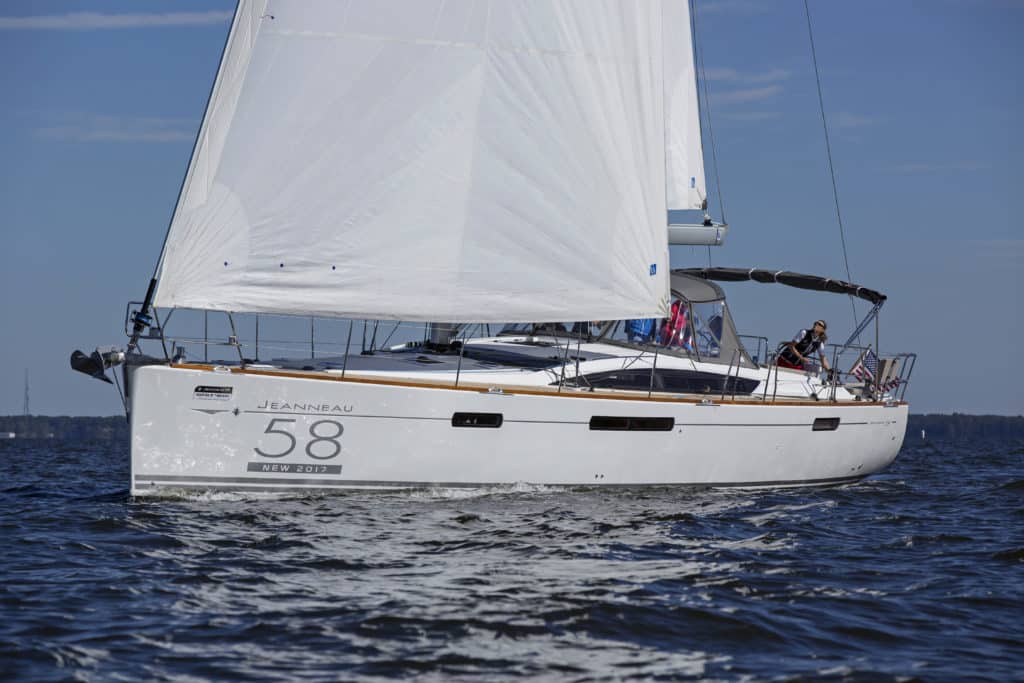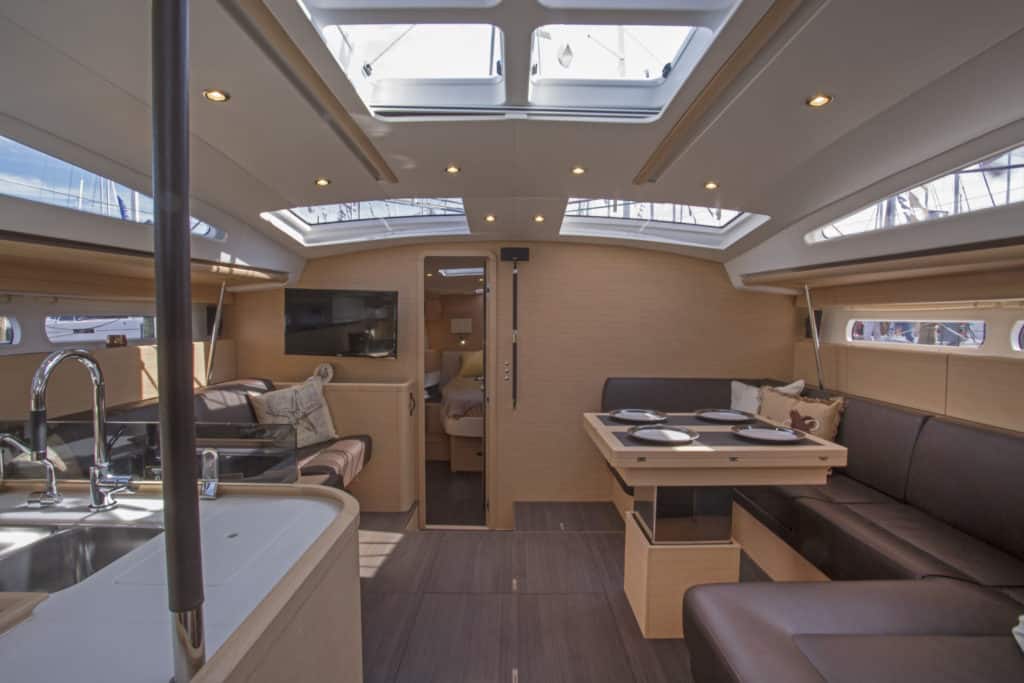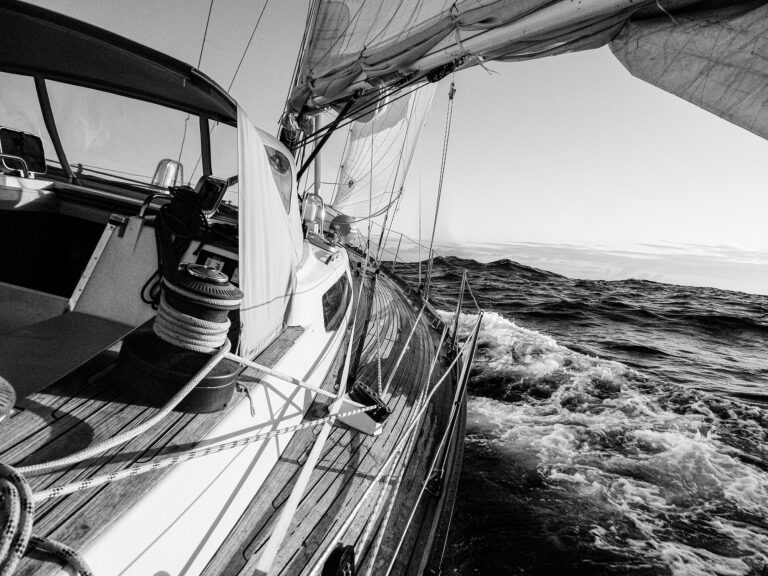
In recent years, more and more builders who forged their reputations on solid, affordable, midsize production sailboats have begun to expand their lines — figuratively and literally — into ever-larger, ever-rangier vessels that combine considerable comfort with greater seakeeping ability. Beneteau, Dufour and Hanse are just three examples of companies that were once ensconced in the roughly 35- to 45-foot range of wholesome cruisers but now produce big, powerful 50- to 60-foot (or larger) craft capable of long-range, long-term voyaging adventures. It might be a relatively new trend, but it’s obviously here to stay.
Add to that list the gang from Jeanneau, who now have a dedicated line they call their Yacht series, which is comprised of a 51-, 54- and 64-footer, along with a fresh addition for 2017, the Jeanneau 58. It perhaps goes without saying, but the 58 is One. Big. Boat.
The collaborative team who came together to create the yacht — the renowned naval architect Philippe Briand, who conceived the lines of the slippery high-performance hull and tall three-spreader rig; Vittorio Garroni, charged with fashioning the deck layout and interior accommodations; and the in-house Jeanneau designers, who addressed the structural details — were handed a simple design brief. Namely, to deliver a world-class luxury cruising boat right from the get-go, with the attendant battery banks and power requirements, ample tankage, and other necessary features built in with a high level of craftsmanship and ready for action. And to do so — gulp! — at an affordable price point, in this case around $750,000 (once canvas, electronics, communications and so forth are all added in).
So, where to begin? At first glance, the obvious place is the long, expansive beamy cockpit, which dominates the deck layout and is truly the focal point of the design (and that’s not even taking into account the gargantuan dinghy garage that’s stationed beneath it). There’s lounging space galore on a couple of different levels, so bring your friends and family. The driver has a choice of twin wheels, both of which have good views of the Raymarine chart-plotter pod attached to the aft end of the central cockpit table, which also contains a fridge. The hardware is dominated by Harken products. There are big Harken rewind winches for the primaries; hefty Harken blocks at the foot of the mast, which lead the running rigging under deck panels and aft to sets of clutches to either side of the companionway; and Harken adjustable sheet leads to dial in optimum headsail trim for the 135 percent genoa. There’s also a double-ended German-style mainsheet but no traveler. The large dodger and corresponding Bimini complete the picture.
Down below on our test boat, there was a large owner’s stateroom forward with a queen-size island berth, a small desk/vanity and a good-size hanging locker; aft, there were a set of double cabins with berths that can slide apart to create a couple of single bunks or be joined together to form a large double. However, this was just one of a startling five optional layouts available, with the possibility of two large cabins at the yacht’s opposite ends; four cabins split evenly fore and aft; and even five cabins with three forward (one of which could accommodate a professional skipper) and two aft. Interestingly, whatever the choice, there’s no change in the cost of the boat.

No matter which layout one chooses, the spacious main saloon remains the same. The galley, to port, opposes an excellent navigation station, to starboard. Forward of the nav space, there’s a long settee flanking an electrically controlled dining table that can be lowered and folded in as a coffee table or raised and folded out to become a full-size dining table. To port, the middle section of the settee can be flipped over to reveal a serving table with an integrated bar. It’s all very clever. With a host of cabin-top windows and additional ports in the hull — not to mention a pair of skylight hatches directly over the cabin — there’s plenty of natural light and ventilation. Nice. So too is the light, sustainable Alpi wood employed in the interior furniture and bulkheads, which further contributes to the clean, airy look throughout. A variety of colors, textures and veneers are available.
Boat of the Year judge Ed Sherman says, “They’ve done some good things electrically if you are indeed going to travel around the world,” noting both the 12- and 24-volt service, the ability to convert power to 110 and 230 volts via an inverter, the generator and a pair of alternators feeding separate battery banks. One thing you won’t run out of is juice.
Construction-wise, the hand-laid hull is solid glass without any use of coring material; an internal grid is glued down and relaminated to the hull, making for an incredibly stiff two-part monolithic structure. Furthermore, the chain plates for the keel-stepped mast are also glassed into the grid, spreading the loads evenly throughout the boat. The deck mold actually falls away aft to incorporate the dinghy garage, which negates the necessity for the full seals and pneumatic systems that are often part and parcel with this arrangement; because it’s an integral part of the deck, there’s no danger of leaks or gas fumes permeating the interior, and so on.
We sailed the 58 on a moderate Chesapeake Bay afternoon in about 8 knots of breeze with slightly higher puffs, and like all Briand hulls, she was quick and a joy to drive, topping off at more than 6 knots hard on the breeze. Once out of the cockpit, moving about on deck was particularly easy and rewarding: There are good, high lifelines; excellent stainless-steel handholds built into the sloping coach roof; and with well-placed inboard shrouds, moving forward on the teak side decks, even with the overlapping headsail, was a breeze.
All in all, the Jeanneau 58 picks up where some of the builder’s smaller offerings end. A long-legged yacht with all the accouterments — not to mention plenty of ways to optimize and personalize it for your crew and your plans, whether it’s a hop down to the islands or a dash across oceans — she’ll take you where you wish to go.
Specifications
LOA: 58’4″ (17.70 m)
LWL: 50’2″ (15.28 m)
Beam: 16’4″ (4.97 m)
Draft: 6’10″/8’2″ (2.08 m/2.48 m)
Sail Area: 1,571 sq. ft. (145 sq. m)
Ballast: 13,448 lb. (6,099 kg)
Displacement: 47,289 lb. (21,450 kg)
Ballast/Displacement: 0.28
Displacement/Length: 167
Sail Area/Displacement: 19.2
Water: 246 gal. (931 l)
Fuel: 111 gal. (420 l)
Mast height: 79’4″ (19.03 m)
Engine: 150 hp Volvo Penta D3-150
Designer: Phillipe Briand Yacht Design/Garroni Premorel/Jeanneau Design
Price: $750,000
Jeanneau America
410-280-9400
www.jeanneauamerica.com
Herb McCormick is CW’s executive editor.








